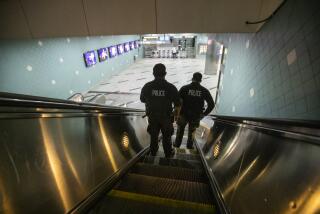Al Qaeda looks at surgical implants to get a bomb past airport security
- Share via
Reporting from Washington — Al Qaeda operatives in Yemen recently discussed surgically implanting an explosive device under the skin of a suicide bomber to get past airport detectors and blow up a U.S.-bound passenger plane, a U.S. official said Wednesday.
There is no indication of an immediate plot, but the government has warned airlines, stepped up security at U.S. airports and encouraged other countries to adjust security measures.
The focus is mostly on international flights, but domestic passengers are likely to see more bomb-sniffing dogs and an increased use of swabs that test for traces of explosive material on hands and luggage.
The potential for terrorists to surgically implant bombs has been examined by intelligence agencies in the past — Britain’s MI5 agency issued a report on the possibility last year. But new information suggests that the branch of Al Qaeda in the Arabian Peninsula has seriously considered the tactic, said the U.S. official, who spoke on condition of anonymity because of the sensitivity of the information.
As a precaution, the U.S. is adding an “unpredictable” regimen of security measures, said Nicholas Kimball, a Transportation Security Administration spokesman.
“Passengers should not expect to see the same activity at every international airport,” he said. “Measures may include interaction with passengers, in addition to the use of other screening methods such as pat-downs and the use of enhanced tools and technologies.”
Since the U.S. increased its use of body scanners last fall, terrorist groups have repeatedly indicated an interest in pursuing new ways to conceal explosives, said a U.S. security official, who also spoke on condition of anonymity because of the matter’s sensitivity.
Security experts said sewing a working bomb inside a passenger’s body would be possible though far-fetched. Such a device could be detonated wirelessly by a cellphone or radio-controlled trigger.
Rather than resorting to surgery, it would be easier to insert a bomb into a body cavity, as drug smugglers have done with their stashes for years, said Douglas Laird, a consultant and former head of security for Northwest Airlines.
A surgically implanted device would be difficult but not impossible to detect. The current scanners used on some passengers can detect anomalies only on the surface of the body, but if the implanted explosive left an unusual lump on the skin, that could appear on the scan.
But unless the device was inserted in a perfectly sterile environment, small particles of explosive could be picked up by bomb-sniffing dogs and machines designed to detect such traces. A passenger who has a bomb implanted also might appear sick, which could be noticed by TSA screeners trained to watch for unusual behavior.
The best way to detect explosives inside a body would be through a full body X-ray, which is not used for airport screening because the dosage of radiation is too high, Laird said.
The Yemen-based branch of Al Qaeda has been linked to a number of bomb plots using malleable explosives that can be easily hidden and are difficult to detect.
In October, the group hid makeshift bombs in packages to be carried on cargo planes headed for the U.S. One of the packages, discovered in Dubai, flew on two passenger airliners before it was found after a tip by the Saudi intelligence service.
On Christmas Day 2009, a Nigerian bomber, Umar Farouk Abdulmutallab, passed through airport screening in Amsterdam and boarded a flight bound for Detroit with plastic explosives sewn into his underwear. His plot failed and he admitted to interrogators that he had been trained and outfitted with the bomb by the Yemeni group, known as Al Qaeda in the Arabian Peninsula.
Those devices used the explosive PETN, pentaerythritol tetranitrate, a powder about the consistency of salt that has been a staple of Al Qaeda bomb makers for nearly a decade.
PETN gives off relatively little vapor, making it more difficult to detect by dogs and the swabs used by the TSA. But the material requires a detonator, which typically uses materials that are easier to trace.
Informing airport security officials about terrorists’ possible use of implanted explosives can help keep airlines and screeners on alert for unusual signs, the U.S. security official said. “It helps to keep the possibility in the back of the mind.”
More to Read
Sign up for Essential California
The most important California stories and recommendations in your inbox every morning.
You may occasionally receive promotional content from the Los Angeles Times.










